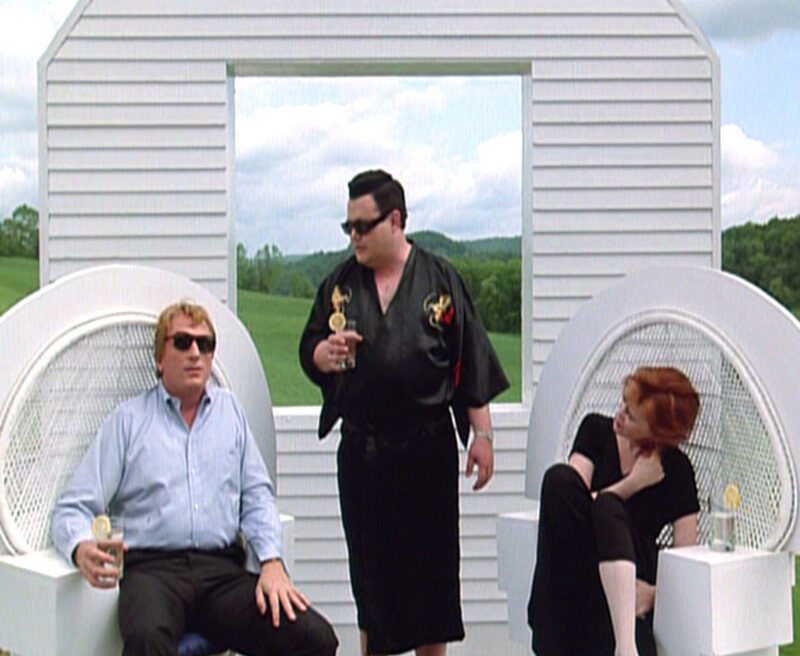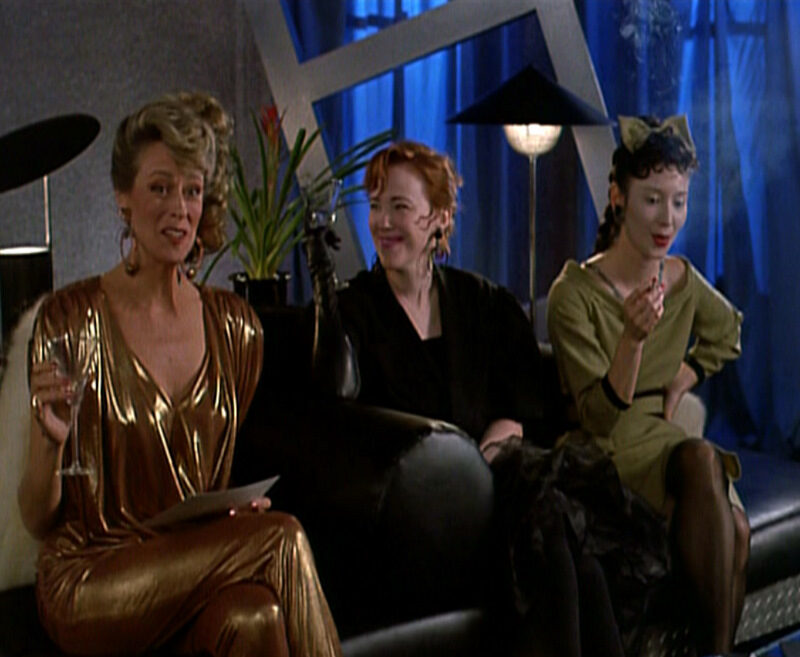Dual Analysis: Beetle Juice – Chris’ Thoughts | Clothes on Film
Part one of a new Dual Analysis costume film review.
Attesting that upbeat and silly often go hand in hand, Beetle Juice (1988) stands as one of director Tim Burton’s most cheerfully insane projects.
If its blend of fantasy, horror, comedy proves too much for some, then the imaginative costumes by Aggie Guerard Rodgers and Bo Welch’s vibrant production design save the film from merely a cult following. Yet there is so much to see in Beetle Juice that the real enjoyment comes from re-viewing.
This spooky tale revolves around the recently deceased Maitlands, Adam (Alec Baldwin) and Barbara (Geena Davis). Just coming to terms with dying and forced to spend 125 years stuck inside their old house, this quaint country couple also have to put up with the new, very much alive proprietors.
A lamentable combination of avant-garde and nouveau riche comprising stressed dad Charles Deetz (Jeffrey Jones), arty stepmom Delia (Catherine O’Hara), unhappy daughter Lydia (Winona Ryder) and pompous interior designer Otho (Glenn Shadix); these inhabitants invade the Maitlands’ space with all the subtlety of a bulldozer (which they actually bring along).
Charles wants the quiet life though and is keen to stay out the way while Delia and Otho go about remodelling the house into something she considers habitable; Lydia on the other hand is a black clad teenager, depressed as per the archetype, and the only living person able to see the Maitlands as ghosts.
Tired of this intrusion, Adam and Barbara want their awful tenants out of their house for good (the grown ups anyway, they gain an affinity with Lydia). This is where Beetlejuice (Michael Keaton) comes in. A self-coined ‘Bio Exorcist’; Beetlejuice can be summoned from the grave by uttering his name three times. Though woe betides those who do; he is a filthy, foulmouthed, perverted moron liable to cause more trouble than he solves. Unfortunately the Maitlands do not realise this until they dig him up, and by then it’s too late.
Aggie Guerard Rodgers’ brilliant, sometime barmy costumes are a highlight of the film. They define each character to such a degree that little time is wasted interpreting their backstory. This is important as Beetlejuice only runs 92 minutes; the story is slight and zips along at a fair lick.
As cookie cutter wife Barbara, Geena Davis’ costume was based on the prim Laura Ashley model of high neck, long skirt with buttons down the front, and often eye-straining flower overprints. Due to Davis’ lofty height all dresses (several in identical prairie style and a wedding dress) were made to measure. Guerard Rodgers states she had to get Burton on board with the whole Laura Ashley idea, but that he was completely won over upon seeing the actual outfit.
For Alec Baldwin’s khakis and flannel wearing hobby carpenter Adam, Burton was clear about wanting a bold plaid, though it took several samples for him to decide on a perfect pattern for the shirt. In part thanks to costume, in part Baldwin’s laidback performance, we quickly recognise Adam as a decent small town guy who fulfills the alpha male contingent without hammering it home. In other words he comes across like good dad material.
For Catherine O’Hara’s insufferably snobby Delia, the look was 100% Japanese designer. All her clothes were purchased during an afternoon at Maxfield’s boutique on Melrose Avenue. Then antique store dweller Burton was apparently shocked at the prices and O’Hara had never heard of any of the designers; these included such up and coming Asian labels as Issey Miyake, Rei Kawakubo of Comme des Garçons and Mitsuhiro Matsuda.
Moneyed 1980s was the decade for Japanese designers that had arrived with deconstructionist, largely monochrome creations as antidote to the likes of Claude Montana and Gianni Versace with their lurid colour schemes.
Delia’s entire wardrobe was put together on this solitary excursion into West Hollywood, even the ‘gloves hat’ (read: tied around her head) for the Cantonese family supper. In keeping with the fashion victim aesthetic, Guerard Rodgers reused an orange and cream sweater worn by Jeffrey Jones as a skirt for O’Hara in a later scene (when making dinner). Apart from perhaps Lydia, Delia remains the only character to out-weird Beetlejuice in costume terms.
As Lydia it was Winona Ryder who became most defined by her costumes in the film; this goth-a-like look would follow her about for years to come. Aided by flawless alabaster skin, dark hair and dark eyes, she was a perfect fit for black, black, and a splash of red.
Ryder’s costumes were purchased at American Rag in San Francisco by Guerard Rodgers, the actress herself and her parents. Rumour has it a final change outfit was procured from the closet of Ryder’s own grandmother (that long black petticoat worn under the plaid skirt for the ‘Jump in the Line’ number perhaps?).
It was already stated in the script that Lydia would wear a wedding dress for the finale, though it was Aggie Guerard Rodgers who suggested the blood red version, as sourced from a store in downtown L.A. that made similar gowns for the Latin community. On hearing the suggestion, Burton apparently just smiled his response. Translation: the outfit was in. Even now this vintage style gown with its high neck and full tiered skirt is a favourite for theme weddings and Halloween parties.
Jeffrey Jones’ costumes were a designer mix. Apart from the aforementioned orange sweater, he dons a noticeable Giorgio Armani cardigan for the moving-in scene. His Aquascutum club check jacket and velvet collar worn later on is presumably a vain attempt by Charles to be lord of the manor.
It was intended Otho follow a comparable visual identity to Delia. Unfortunately none of the Japanese clothes fitted actor Glenn Shadix so his costumes were created from scratch inspired by English magazines of the era. The first time we see Otho he is dressed in a hopelessly fashionable black knit jacket with Aztec slim Jim and red leather shoes. This contrasts sharply with the blue polyester lounge suit Beetlejuice conjurers him into at the end. Assumedly for Otho such a sartorial gaffe represented a fate worse than death.
Creating Michael Keaton’s look as titular Beetlejuice involved a lot of rummaging, principally on stage 22 at Warners. Likewise stripper outfits for the brothel girls were sourced here (with added ruffles from the costume designer’s own kiddie skating garb).
Keaton’s cowboy ensemble was found at 22 and bolstered with padding. The black and white striped suit, definitely his character’s most famous guise, was based on an original sketch by Tim Burton. Guerard Rodgers and cutter Carmen Mazro then put finished article together in a makeshift shop erected on the lot.
In the 21 years since Beetle Juice’s theatrical release special effects have moved on somewhat. It would not be unfair to say that the film has dated quite spectacularly in this respect. Take the stop-motion sand worm; it’s quaint, but so visually obtrusive as to almost take you out of the narrative entirely.
Though testament to Burton is that in the grand scheme of things this really does not matter; the experience remains the same. Every frame is presented as a mini work of art. Costumes too are more like installations by the final reel; Keaton’s ‘mallet arms’ getup for example is both absurd and awe inspiring.
Yet the story is affecting even without FX dramatics. At its core we have a loving, childless couple (a brief shot of an infant photo indicates a bereavement in their past) lost in a world they do not understand. They learn to adjust, live with their new neighbours and even become surrogate parents to a disenchanted teenager. All this and they remain dead. For even with its upbeat Harry Belafonte calypso ending, Beetle Juice does not cop out and bring the Maitlands back to life. They died in the first ten minutes and sure enough they will stay that way.
The movie works best as an out and out comedy however. Any time Keaton turns up the heat as Beetlejuice is worthy of a mention (“Nice F***ing model!” being his fieriest zinger). The Deetzes soirée is perhaps the funniest scene overall. Another Belafonte musical number, the comedy again comes from miming. Catherine O’Hara’s confused face as she mouths out lyrics to The Banana Boat Song is a picture. Moreover the costumes are riotous; glitzy New York couture at its glitziest. That’s some serious glitz.
House guests are dressed head to toe in Dynasty-era glad rags. While most of the clothes came from stage 22, the conspicuous gold jumpsuit was bought off the peg at Saks. Adele Lutz, wearing a light green dress with heavily made-up ghostly pallor, chose her own outfit shopping in New York with Guerard Rodgers.
If it had not been broadcast enough we get an absolute sense of the Deetzes’ cultural emptiness by measuring them against the company they keep; the type of people they invite to dinner smoke instead of eat. Lydia for all her sad sack facial expressions and an ominous black is by far the most ‘normal’ person in attendance.
There is not a single weak performance in the film from a cast clearly enthusiastic about the material. Everyone gets their turn to shine, even the prophetics and walk-ons. Patrice Martinez as green skinned Miss Argentina (her costume inspired by a popular Saturday morning space serial) and Barry the shrunken head being the two most memorable examples.
Probably a more loveable experience than was ever intended, Beetle Juice is comfort food for those on their way out. Thanks to Tim Burton and company, being dead comes across like one giant party.
With thanks to Aggie Guerard Rodgers.
© 2009 – 2011, Chris Laverty.
Related Posts:














